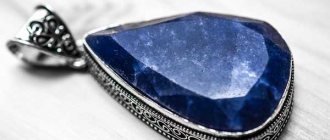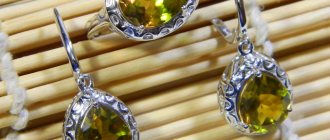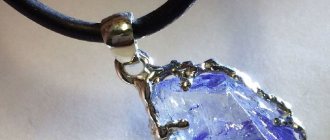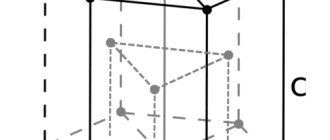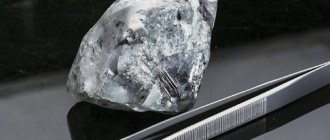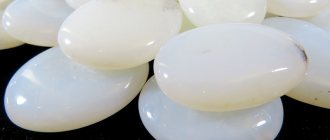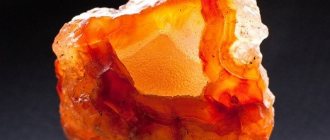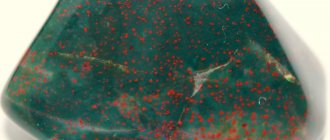History of the discovery of diamond
Rough diamonds.
Photo: annamoltkehuitfeldt.wordpress.com The exact time of the discovery of the diamond has not yet been established. The thing is that the appearance of unprocessed minerals is quite trivial and does not attract much attention. The first mentions of Indian stones date back to the 3rd millennium BC, but they began to be used in jewelry only about 500 years ago, after craftsmen mastered diamond cutting methods. Advertising - Continued below
In Russia, Catherine II had a special love for them; during her reign, the concept of a diamond came into use as a synonym for wealth and luxury.
The name of the mineral in different languages has a similar sound and meaning. The Arabs called it “almas”, that is, “the hardest”, the Greeks called it “adamas”, which means “indestructible”. The Russian word “diamond” was introduced into circulation in the middle of the 15th century by the traveler Afanasy Nikitin in the book “Walking across Three Seas.”
Prices for diamond products
The price of diamonds depends on the weight, quality of cut, color and clarity of the stone.
1 carat is 200 mg. Stones weighing from 15 carats are rare, and more than 100 carats are unique. The most popular diamonds weigh 0.1 carats and cost up to $200. Samples weighing from 1 carat cost from $5,000 per carat.
Physicochemical properties of diamond
Yakut rough diamonds
Diamonds are transparent, colorless minerals, less often they have pink and yellow shades, they have a bright shine and high refractive indexes.
Advertising - Continued below
The mineral consists of carbon atoms equidistant from each other at a distance of 0.15 nanometers. The atoms form a cubic crystal lattice, giving diamond the highest hardness on the Mohs scale—10. However, due to perfect cleavage, crystals are very fragile, and the erroneous identification of the concepts of hardness and fragility often led to the destruction of valuable stones.
This is how the collection of diamonds of the French Duke Charles the Bold, who waged an internecine war with the king, was destroyed. The mercenaries of Louis XI, wanting to test the authenticity of the stones with a hammer, turned them into powder.
How to distinguish a real diamond from a fake
Colorless zircons, sapphires, and crystal are used as fake diamonds. To distinguish a fake stone:
- They look at it in the sun. A real diamond shows one bright point, while imitation diamonds allow light to pass through.
- Thermal conductivity is measured, which is very high in diamond, unlike other stones.
- They use a felt-tip pen with thick ink, which leaves a straight line on the surface of a natural diamond, and separate drops on a fake diamond.
- An aluminum stick is used. It will not leave a mark on a wet natural stone, but on a fake one it will form a clear silver line.
But distinguishing a natural diamond from a synthetic one is almost impossible.
In any case, it is better to entrust the diamond assessment to a specialist, since it is quite difficult to distinguish a high-quality fake.
Diamond formation and deposits
“Mir” kimberlite pipe 525 meters deep
It’s hard to believe, but diamond and graphite are practically twin brothers. Both are pure carbon. In order for graphite to crystallize, special conditions are required: a pressure of 45,000−60,000 atmospheres and a temperature of 900−1300 °C, which are provided at a depth of 80−150 km underground. Together with volcanic magma, stones are ejected from the bowels of the earth, forming primary deposits - kimberlite pipes.
Advertising - Continued below
Scientists also know minerals of meteorite origin, formed during the collision of a cosmic body with the surface of the Earth. The temperature at the moment of impact reaches 3000 °C, and the pressure reaches 100 GPa; under these conditions, diamond-bearing impact rock is formed. “Unearthly” stones were discovered in the Grand Canyon in the USA in fragments of a meteorite that fell about 30 thousand years ago. Yakutia also has its own similar deposit - the Popigai astrobleme, formed 35 million years ago.
The development of impactites is unprofitable due to the small size of the crystals, so industrial mining is carried out using traditional methods in “terrestrial” deposits, which are found on almost all continents, and the largest are located in South America (Brazil), Russia (Yakutia), Africa (Botswana, Angola).
Material properties
Before finding out what the melting point of diamond is, let's look at the properties of the mineral:
- Diamonds have the highest hardness of any existing fossil. For this reason, no material is capable of destroying the structure of a diamond or scratching its surface. He himself can damage any physical object.
- Diamond is a highly effective insulator. It is resistant to acids and other aggressive chemical environments.
- Diamond has the highest thermal conductivity of all solid minerals. The gem can be held in the palm of your hand as long as you like. At the same time, its temperature will remain unchanged.
- Diamond has a unique luminescence. Light rays of any origin, when passing through a mineral, make it glow brightly and shimmer with all the colors of the rainbow.
Artificial diamonds
Scientific experiments on creating artificial diamonds began in 1797, but the first mineral grown in the laboratory and the method for its production were patented by the American company General Electric only in 1956. Since then, technology has advanced so far that today many artificially grown stones are completely indistinguishable from natural ones without special equipment and extensive experience, and conventional methods of recognizing a fake do not always work.
Advertising - Continued below
However, the saturation of the market with such stones is restrained by the law of supply and demand, since the fall in prices for diamonds is unprofitable for either miners of natural or artificial stones.
Known analogues of natural diamonds
It is worth mentioning the most common stones that are used in jewelry instead of diamonds. Firstly, these are well-known cubic zirconias, first synthesized at the Russian Institute of Lebedev Physical Institute. Secondly, these are moissanites, which are especially difficult to distinguish from a real gemstone without the necessary knowledge.
Rough comparison of natural diamond, moissanite and cubic zirconia
In addition, relatively recently, ASHA diamonds have appeared, the surface of which is covered with a layer of carbon atoms (of which the natural mineral is composed), which actually makes such a stone a composite material and at the same time gives it more shine and “fire” compared to the same cubic zirconias.
Advertising - Continued below
Special mention should be made of HPHT (high pressure, high temperature) diamonds. This method was developed in the 1950s and the resulting stones are actually completely natural.
The essence of the method is not difficult to understand if you remember the conditions for the formation of the stone. In nature, diamond is formed under the influence of colossal pressure and temperature over a certain period of time. Sometimes such stones reach the surface ahead of time, essentially representing a “semi-finished product.” And in order to turn it into a beautiful sparkling diamond, which will later be cut and inlaid, the stone is repeatedly exposed to high pressure and high temperature, similar to natural ones, but in the laboratory. Such a diamond remains completely natural, but as if “modified” by people.
A visual comparison of a real diamond (in the center) with its analogues: 1 - cubic zirconia, 2 - moissanite, 3 - ASHA diamond, 4 - laboratory-grown diamond
Interesting properties studied during experiments
Diamond is the most amazing stone. Its nature and properties force the smartest people on the planet to solve the most difficult problems. His beauty delights millions. It is one of the best dielectrics and insulators. It contains only carbon atoms.
It is curious that carbon itself is an extremely flammable substance. In nature, it is most often found in the form of graphite. This gave scientists the idea of converting one substance into another. They were interested in whether, during the melting process, diamond would transform into graphite and vice versa. The results were mixed.
It turned out that it is possible to create graphite from diamond by heating the crystal to 2000 degrees and blocking the access of oxygen. But it was not possible to carry out the reverse reaction without making a seed. You can read about this in the article “About artificial diamonds and polished diamonds.” If the stone is not heated in a vacuum, it will simply turn into carbon.
Magical and healing properties of diamond
Lithotherapists believe that diamond accelerates the renewal of body cells, promotes cleansing, and fights infections and parasites. In many teachings it is used as a rejuvenating agent.
Advertising - Continued below
Yogis use diamond to treat mental illness, heart, kidneys, and cleanse the liver. Warriors wore diamond rings, believing that it would give them fortitude and make them invincible. In addition, the stone brings happiness to the owner and protects against bad habits and actions.
Do diamonds exist in molten form in natural conditions?
The melting point of diamond is so high that the mineral can no longer exist in boiling form on Earth.
However, what about space objects? According to scientists, the melting point of diamond is still maintained in the depths of planets such as Neptune and Uranus. It is noteworthy that the latter are 10% formed from carbon, which is the structural basis of this mineral. According to many scientists, on the above planets there are entire oceans of diamonds in liquid, boiling form. This hypothesis explains why the magnetic field of these celestial bodies behaves so strangely. After all, Neptune and Uranus are the only planets in the solar system whose geographic poles do not have a clear position and are literally separated in space. To confirm an interesting hypothesis, all that remains is to simulate similar conditions on Earth experimentally. However, such a solution currently remains extremely expensive and time-consuming. Therefore, it is not yet possible to determine for sure whether there really are entire oceans of molten diamonds on nearby planets.
Who will benefit from diamonds and diamonds?
Graff yellow diamond necklace with 132 carat Golden Empress center diamond
Ring Tiffany & Co. with colorless diamonds and a blue diamond in the center
Diamond, like diamond, is the stone of the brave and determined. It requires a respectful attitude and may be useless in the hands of a weak, insecure person.
Varieties and colors
What colors does this stone have?
Diamond color is an ambiguous concept. Almost all types of diamonds are characterized by two main characteristics: their own color and luminescence, that is, the shade of light radiation passing through the stone. The color of most mined diamonds is yellowish, which is partially offset by blue luminescence, as a result of which the stone becomes colorless in the perception of the human eye.
Colored diamonds
Few transparent crystals of “pure water” are mined. Stones of jewelry quality include only crystals with blue luminescence and a complete absence of yellow tone in color, only a light brownish tint is acceptable.
Color is a term from the language of diamond sorters and cutters. It means a light, subtle shade that determines the type of diamond: whether this specimen will go into jewelry, whether it will become the basis for the manufacture of a diamond, or whether it is destined for industrial use. For example, a drill bit for a diamond drill.
This is interesting: 98% of mined diamonds are of industrial value. These are yellow stones.
The color of a diamond is an inexplicable phenomenon, since there are no other inclusions in the mineral that give it a particular color. Other natural minerals contain inclusions of iron, calcium, copper, chromium, titanium and other elements, thanks to which they acquire their color. But not adamant. There is a hypothesis that the type of diamond and its color are determined by the degree of exposure of the stone to natural radiation.
Red diamond
Diamonds of blue and pink shades are rarely found in nature, but even more rarely are stones of rich colors: green, red, bright blue. The price per gram of such crystals ranges from hundreds to thousands of dollars depending on other characteristics. Red stones and black crystals are quoted the highest, while blue and green gems are given a little less on the world market. But this is a very conditional assessment, since the value of polished diamonds is not determined unambiguously, like, for example, gold - by weight. No appraiser can say how much a diamond costs “on average” without looking at the stone. With diamonds it is simpler in this regard - the cost of one carat of a colorless, standard-cut diamond, without defects or tints, is about a thousand dollars. 1 carat diameter (standard diamond cut, viewed from above) - 6.5 mm.
After cutting, a diamond may be halved or tripled in size, but its price will increase 3 or 4 times. Often, it is more profitable to turn one natural diamond of the correct octahedral shape into 2 smaller diamonds.
Morphology
The “50 Years of October” diamond is octahedral in shape, weighing 121.66 carats. Tube "Mir". Yakutia (Russia).
A. crystallizes into cubic systems. The most important crystallographic A. forms: flat-sided (arising during crystal growth) - octahedron, rhombic dodecahedron, cube and various combinations thereof; curved (formed when crystals dissolve) - dodecahedroids, octahedroids and cuboids; There are also more complex combined forms, twins of intergrowth (according to the spinel law) and germination. The edges of crystals are often covered with figures of growth and dissolution - protrusions, depressions and steps. Among polycrystalline Aggregates include ballas (spherical spherulites with a radial structure), intergrowths, carbonado (hidden and microcrystalline aggregates of irregular shape, dense or slag-like), carbonado with lonsdaleite (hexagonal modification of carbon) and board (irregularly shaped fine- and coarse-grained polycrystalline formations). A.'s size ranges from microscopic. grains to very large crystals weighing hundreds and thousands of carats. The weight of mined diamonds is usually 0.1–1.0 ct (1 ct = 0.2 g); large crystals of St. 100 carats are very rare; As a rule, such stones are given their own names (Table 1). From the largest one, “Cullinan”, 105 diamonds were made, including “Star of Africa” (“Cullinan I”) of 530.2 carats and “Cullinan II” of 317.4 carats, which are inserted into the imp. crown and scepter of Great Britain. The largest grew. A. (342.5 ct) was found in Yakutia (Mir pipe).
Table 1. The world's largest diamonds
| Name | Weight, car | Place of discovery - country, mine | Year of discovery | Number of diamonds obtained from a diamond | Weight of the largest diamonds, carats |
| "Cullinan" | 3106,0 | South Africa, Premier | 1905 | 105 | 530,2; 317,4 |
| Untitled | 1640 (broken) | South Africa, Premier | 1919 | … | … |
| Untitled | 1195,5 | South Africa, Premier | 1924 | … | … |
| "Excelsior" ("Excelsior") | 971,50 | South Africa, Jachersfontein | 1893 | 21 | 69,8; 47,15 |
| "Star of Sierra Leone" | 968,90 | Sierra Leone, Yengema | 1972 | 17 | 153,96 |
| "Great Mogul" | 778,00 | India, Golconda | 1304? | … | 280 |
| "Victory Diamond" | 770,00 | Sierra Leone, Koidu | 1945 | 30 | 31,35 |
| "Nameless Brown" | 775,5 | South Africa, Premier | 1986 | 1, "Golden Jubilee", the world's largest | 545,67 |
| "President Vargas" | 726,60 | Brazil, Diamantina | 1938 | 29 | 48,26 |
| "Jonker" ("Jonker") | 726,00 | South Africa, Transvaal | 1934 | 12 | 125,65 |
| "Anniversary" | 650,80 | South Africa | 1895 | 2 | 245,35 |
| "Dutoitspan" | 616,00 | South Africa, Duthoitspan | 1974 | Not cut | |
| "Baumgold" | 609,25 | South Africa | 1922 | 14 | 50,00 |
| "Lesotho Brown" | 601,25 | Lesotho, Letseng la Terae | 1967 | 18 | 71,73 |
